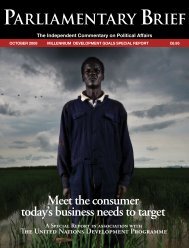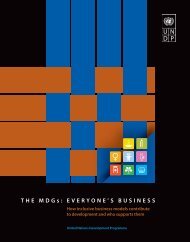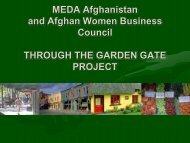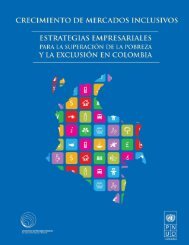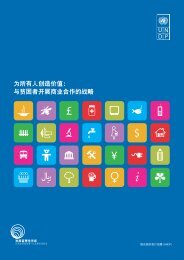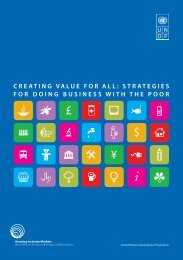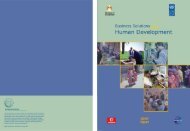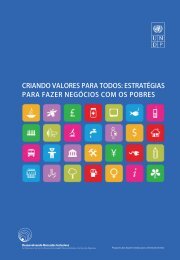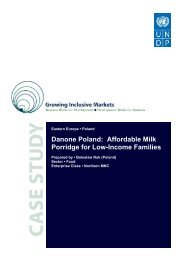Iran Kandelous 2011 - Growing Inclusive Markets
Iran Kandelous 2011 - Growing Inclusive Markets
Iran Kandelous 2011 - Growing Inclusive Markets
You also want an ePaper? Increase the reach of your titles
YUMPU automatically turns print PDFs into web optimized ePapers that Google loves.
Middle East • <strong>Iran</strong><strong>Kandelous</strong> Agro-Industry GroupPrepared by • Hamed GhoddusiReviewed by • Shuan SadreGhaziSector • Agriculture, Tourism, Consumer ProductType of lead organization • Large domestic
Executive Summary<strong>Kandelous</strong> Group is a conglomerate consisting of a profit based combination of a herbal business,rural tourism, and cultural activities. It has introduced the concept of mass production of naturebasedand herbal medicine, cosmetics, oils, foods and hygiene products combined with ruraltourism in <strong>Iran</strong>. The Company entered the market in 1984 and continues to produce and sell morethan 125 types of herbal products in a profitable way in the domestic market as well as exportingthose products to seven countries.The Group has served the local population through establishing its activities in <strong>Kandelous</strong>, aremote and isolated village in the North of <strong>Iran</strong>, and the birthplace of the founder. It hassubsequently become a successful role model of a pro-poor business that has linked theinhabitants and resources of an isolated region to outside customers. The outcomes havesignificantly changed the economic base of the region as well as the living conditions of manylocal low-income residents. The production in the village not only has improved the skills,mentality and attitudes of the local inhabitants toward entrepreneurial activities but has alsocreated more than 200 direct and several indirect jobs. Moreover, the Company has conservedand benefited the environment by planting new species of plant life, introducing natural productsto the urban consumers and effectively increasing their awareness and regarding the importanceof living a natural lifestyle and maintaining superb environmental quality.Kandalous’ approach is an excellent example of how innovative and responsible integration ofbusiness, tradition, natural resources and environmental awareness can create positive synergiesamong these elements. The company converts plentiful resources of the region into high valueaddedconsumer products and redistributes a large proportion of the value created to the localcommunity in the form of either wage or investments. Moreover, it promotes its consumerproducts through convincing the consumers that part of the money that pay for these products willbe used for regional development and cultural activities. On the other hand, the presence of theconsumer products in more than 2,400 drugstores in <strong>Iran</strong> and several branches in Europe and Asiahas introduced the village to urban and foreign visitors as well as attracted more than 50,000tourists per year.In summary, the company’s activities are important from an inclusive perspective for two majorreasons. On the one hand, by establishing herbal production units, the company employs labourfrom the local community. On the other hand, the visitors to the region directly purchase localservices and goods from the community. Both of these aspects are examples of connecting anexcluded population to outside markets. Increasing the share of monetary-based (as opposed tobarter transactions) and non-farm activities in the region, has helped the local economy to becomemore diverse and less dependent on agricultural means, therefore presenting themselves as lessvulnerable against negative agricultural shocks.Case Study ● <strong>Kandelous</strong> Agro-Industry Group 2
Introduction“I started my business at the age of eight when I was selling sugar and tobacco from our familystorage to buy old books and antiques”Dr. Jahangiri, CEO of <strong>Kandelous</strong>The company started officially in 1984 by Dr. Ali A Jahangiri, an <strong>Iran</strong>ian manager andentrepreneur who had the experience of managing several pioneering ventures in the chemicalindustry between 1975 and 1985. The Group started the business of mass production of packagedherbs around 1985 and still works as a family-owned business; though the company employsprofessional managers too.In 2005, the Seybon Group of Companies was established as the parent company of the<strong>Kandelous</strong> Group in order to efficiently manage its growth phase. The parent company managesseveral business lines in real estate, trading, herbal products, distribution, cultural products (booksand music CDs), rustic museum and rural tourism, graphics, consulting and some otherbusinesses. Seybon Group is currently run by the son of the founder, Mr. Kasra Jahangiri, aUniversity of California, Los Angeles (UCLA) business graduate.The entrepreneur established the venture with the following goals:• Promoting regional development in the Kojur region and particularly <strong>Kandelous</strong> village(his birthplace) through production of high-quality herbal goods usingendogenous resources.• Conservation of cultural heritage via collecting antiques, old songs, books, manuscripts,stories, photos, etc. to keep and demonstrate them in a rustic museum.• Providing better quality of life for urban consumers by offering natural, ‘green’ food andcosmetics.Over time, the company succeeded in becoming not only a viable commercial entity but also asocially beneficial initiative by offering the following propositional values:• Finding new high-value-added applications for herbs and plants of the region• Providing opportunities of enjoying rural tourism to urban population for the first time inthe country• Maintaining biodiversity by conserving the rare local plant species and bringing newtypes of herbs to the region• Creating jobs and increasing the social and economic contribution of rural poorCase Study ● <strong>Kandelous</strong> Agro-Industry Group 3
<strong>Iran</strong> and the Geography of the RegionThe company is located in the northern part of <strong>Iran</strong>. According to the last census in 2009, thepopulation of <strong>Iran</strong> is close to 66.5 million. The per capita GDP is US$12,000 in purchasing powerparity (PPP) and the official unemployment rate fluctuates between 10% and 14%. Theurbanization rate is 68% increasing by 2.1% per year. This means that the net migration fromrural to urban is positive, a sign of better income expectation in the urban areas. 1<strong>Kandelous</strong> village belongs to the Kojur region, adistrict of Noshahr city in Mazandaran provincein the North of <strong>Iran</strong>. The village is located in avalley of Alborz mountain with an altitude of1,650 metres from the sea level. The economy ofthe region had been mainly based on agricultureand cattle. However, some families earn extraincome through making local handicrafts andselling them to urban areas. According to a 2006census, the population of the village is 2,500.Consequently, due to the seasonal demand forworkers, the population sometimes reaches a high of 3,500. 2To access the village, one should deviate from the main road connecting Tehran to Chaloos (oneof the main tourist cities in the North of <strong>Iran</strong>) and drive for 42 km. Before <strong>Kandelous</strong> Group hadstarted its activities, there was not a proper connection between the village and the main roadsand therefore the village never experienced urban visitors. Building proper roads was one of thefirst activities of <strong>Kandelous</strong> Group.History of the Business, Incentives and Drivers“I belong to that land. When I became rich after successfully establishing my chemical company,I thought it is time to serve the poor people of the region. At the beginning I was delivering basiclivelihood to the village’s poor. Later on I realized that I have to teach them fishing, instead ofgiving them the fish”.Dr. Jahangiri, CEO of <strong>Kandelous</strong>The founder was looking for means to provide a better life for the inhabitants of the village whowere suffering from poor economic conditions, little access to modern educational and healthfacilities and seasonal unemployment. Expertise in chemical industry in addition to personalskills and an entrepreneurial character helped the founder realize that a village with a wide1 CIA World Fact Book: https://www.cia.gov/library/publications/the-world-factbook/geos/ir.html2 http://www.iranchto.ir/Webforms/Fa/Tourism/TourismInfo.aspx?ID=208Case Study ● <strong>Kandelous</strong> Agro-Industry Group 4
availability of wild plants can be a great source of nature-based products. ‘Herbal products’ werethe practical means to materialize this plan. The basic idea was proposed by the founder;however, in later years (around 1985-1986) the local people decided to help him and took animportant role in the preparation of infrastructure in addition to be paid for collecting naturalplants and herbs.Jahangiri's social character had already helped him to form a vast network of professional friendsand business partners. Through causal contacts within his world-wide network, he managed toidentify several species of plants which could be used for production of medicine, cosmetics,foods and drinks. Figure 1 presents a time-line of important events in the life cycle of <strong>Kandelous</strong>Group.Figure 1: TimelinePRO-POOR ASPECTSPro-poor activities of the company started in the early 1980s by the unofficial opening of‘<strong>Kandelous</strong> Help Foundation’, which then became a formal institution. The founder invested inbuilding a primary school (built by the founder but run by the government), small incomegenerating projects for youth (e.g. collecting plants or helping in construction work) anddistribution of basic livelihood to poor habitants. Since the founder found these activities usefulbut not sustainable he turned into more pro-poor business type of activities using innovativebusiness models.The literature on pro-poor and bottom of pyramid activities mentions various strategies toimprove the life of the poor. One strategy is to connect the local poor to the outside world andCase Study ● <strong>Kandelous</strong> Agro-Industry Group 5
then create a market for local resources. 3 There are several technical, managerial and financialbarriers which hinder the local population from making this connection themselves. <strong>Kandelous</strong>Group bridges this gap and unlocks the opportunities in both herbal products and rural tourismbusinesses. In the first area, the company converts low-value natural resources of the region intohigh-value consumer products. The plantation, processing and packaging of these productsrequire a large labour force, most of which is from the local population.By bringing tourists and visitors to the region, unused local capacities such as accommodationfacilities and handicrafts are sold to the outside visitors and the income directly comes to thecommunity.The innovative and synergetic business model implemented by the company serves both theprivate investor and local community. It connects herbal business, culture and rural tourism in away that generates income, creates employment and preserves natural and cultural heritagesimultaneously. The next section explains the operational aspects of this innovative approach inmore detail.Business Model“Instead of planting conventional agricultural products, we grow plants which have 10 timeshigher economic value added”.Dr. Jahangiri, CEO of <strong>Kandelous</strong>Basically, the company serves three major groups of customers:• Domestic and foreign consumers of herbal products• Domestic and foreign visitors to the region, its museums and cultural activities who alsobuy local products• Audience of the region's cultural products (books, music CDs) buying these items in<strong>Iran</strong>ian citiesThe goods and services purchased by visitors are partly produced by <strong>Kandelous</strong> Group and partlyprovided by the local people in the form of rural accommodation, foods, and handicrafts. Thelocal inhabitants have the chance to sell their homemade products to the tourists in the villagestore opened by the company. The goods made by the local community are offered along thecompany’s own products and therefore <strong>Kandelous</strong> acts as a distributor for local small producers.However, during the last decade, some other small shops have been opened by locals to offerthese products and also basic food and drinks. The sustainability of these shops and theemployment and income sources they generate are the direct result of the company’s tourismactivities.3 London, 2007Case Study ● <strong>Kandelous</strong> Agro-Industry Group 6
At the beginning, the company was merely collecting, cleaning and packaging around 40 types ofnatural plants using local labour, and then was selling the packages of dried herbs. The market forthese kinds of products was not so attractive because there was an alternative to buy them fromtraditional Persian herbal medicine shops (Attari, in local languages).In later years, essences, oils, capsules, cosmetics and syrups made from these plants were addedto the product portfolio. There was an increasing demand for such products in domestic andinternational markets as a substitute for chemical medicine. At this stage, the market demand washigher than the amount which was planted and natural capacity of the region could supply.In order to keep the sustainability of the regionand also respond to the growing demand, in1991 the company started establishing its ownfarm by buying lands from local people. Itbegan with the cultivation of two types ofexisting plants which later on extended to morethan 50 types. New medicinal plants asRosemarinus Officinalis, Aloe Vera, Echinaceaand Melissa were brought to the region and arecurrently planted in more than 100 acres of thecompany’s farm using modern techniques. Thelabour to work in the farm was supplied by the local community. The company trained the firstgeneration using on the job training methods. The current workers supervise and transfer theirskills to new employees. <strong>Kandelous</strong> keeps sourcing partially from independent farmers but thisshare is quite small compared to what it produces from its own land.In order to bring the products to the consumers (mostly high-income), the company uses ahierarchical model of exclusive representatives in each province. The company sets the pricingand advertisement policies and uses a performance-based contract with the wholesalers. Thiscontract shares the risks between the two parties. The distributor is responsible for meetingcertain sales targets and also an annual growth rate. On the other hand, the company pays apenalty if its production cannot meet the commitments made by the representatives to localcustomers.In the next layer, they work with drug-stores and traditional herbal shops (Attaris) to manageretail operation. Traditional herbal shops have benefited from <strong>Kandelous</strong>’ activities, since theoverall reputation of herbal medicine concepts has improved a lot by the company’s activities.Some of them use the brochures prepared by the company to introduce their own products.Case Study ● <strong>Kandelous</strong> Agro-Industry Group 7
For the export sector, there are companies and merchants in countries such as United ArabEmirates (UAE), Macedonia and Canada which bring the products to regional markets. Due to thenature of the products, entering foreign markets requires quality tests by government authorities.For example, Bohum laboratories in Germany and the UAE Ministry of Health have to approvethe quality of the products.HERBAL PRODUCTS“Be Healthy, With Nature”, <strong>Kandelous</strong> Group’s SloganHerbal (or botanical) medicines and dietary complements have been known for their healthbenefits for centuries in Middle Eastern countries, including <strong>Iran</strong>. Even in modern days, theirseeds, essence or dried leaves, flowers and roots are sold in the form of capsules, syrups, powder,tea, etc.The global interest in herbal medicine has been increasing in recent years for several reasons.First of all, these products are sometimes cheaper that chemical ones. Second, it is generallybeleived that the side effects of natural products are lower than artificial ones. According to theWHO more than 80% of the world's population is consuming some type of herbal medicine intheir daily life.Although the plants in dried form are valuable enough, taking a profitable perspective, byproducing value-added products such as soaps, shampoos, cosmetics, drinks and essential oil theproducer can gain a much higher profit. Therefore, combining plantation and processing is theright strategy for entrepreneurs in this field.Global and Domestic Market for Herbal ProductsThere is a range of estimates for the size of global and domestic markets for herbal products 4from US$8 billion 5 to US$18.5 billion 6 . According to A. Haji Akhundi, the coordinator of the<strong>Iran</strong>ian initiative for commercializing herbal medicine, currently 120,000 acres of lands in <strong>Iran</strong>are allocated for the cultivation of medicinal plants. 7 There are several other <strong>Iran</strong>ian herbalmedicine companies other than <strong>Kandelous</strong> in <strong>Iran</strong> including Barijessence, Sahajisa, Ghaem-Darouand Cheshme Damavand (Damavand Spring) who produce similar products than <strong>Kandelous</strong>Group. In terms of production they use similar production processes while the distinguishingfactor for <strong>Kandelous</strong> Group is to combine herbal business with rural tourism and also be muchmore diversified than just one business line. Furthermore, <strong>Kandelous</strong> Group produces a widerange of herbal products including foods, drinks and cosmetics whereas most of its competitorsfocus on medical items.4 It was not possible to obtain official estimates on market size, so the report relies on available sources5 http://webiica.iica.ac.cr/TrinidadandTobago/ppt/Globalherbal.ppt6 http://bio.itan.ir/?ID=247 http://www.khorasannews.com/news.aspx?12_17362_11_1304.XMLCase Study ● <strong>Kandelous</strong> Agro-Industry Group 8
<strong>Kandelous</strong> Herbal ProductsCurrently, the company is producing more than 125 different types of products all based onnatural materials. The product portfolio of the company includes a wide range of high-qualitycosmetics, shampoos, deodorizer, hair tonics, candies, spices, herbal medicine, natural essences,oils and hygiene products. Examples of these products in various forms and containers are shownbelow.Sample of Company’s Product Portfolio (Source: <strong>Kandelous</strong>)Table 1: Production Capacity of Different ProductsProductHand lotionsDeodorizersShampoosGelsHair tonicMouth washDried medical herbsGarlic powderSauna solutionsAnnual Production (1000 Kg)60165500220211220255850Source: <strong>Kandelous</strong> Group WebsiteRURAL TOURISM AND RUSTIC MUSEUMIn addition to producing various consumer goods, the Group offers rural tourism services forurban and international visitors. In the past, the <strong>Kandelous</strong> village has never been a target forurban tourists due to lack of information about its natural attractions and the non-existence ofinfrastructure. <strong>Kandelous</strong> Group has had a two-fold effect on bringing tourists to the region.Case Study ● <strong>Kandelous</strong> Agro-Industry Group 9
Initially, it introduced the village through its brand – which has the same name as the village –and encouraged the visitors to come to the region to visit the farms and buy the products directly. 8The company established the first privately-owned rustic museum and rural tourism facilities(including a small hotel and a restaurant) in <strong>Iran</strong> by collecting and demonstrating antiques and oldstuff from the region and other parts of country. This museum now contains thousands of piecesof old music instruments, royal manuscripts, old books, documents, antique appliances, ancientagricultural tools, and jewelries, mostly from Mr. Jahangiri’s personal collection. Additionally, avariety of local songs and music are recorded and preserved by <strong>Kandelous</strong> Cultural Institutewhich runs the museum too. The base of rural tourism was the facilities constructed in mid 1980sand opened in early 1990s. Up to now, very little help from the authorities is given to the culturalcomplex and most of the activities are financed by the founder.A lady from Tehran visiting the village says: “I never thought that here is such a great touristregion. We were coming back from the holiday resort in the North of <strong>Iran</strong> and I just saw the signin the road pointing to <strong>Kandelous</strong> village. As a loyal customer of <strong>Kandelous</strong> herbal products, webecame eager to visit the village itself and are so happy to be here now”. Another touristaccompanying two of his friends in a visit to the village says “If it was mere nature I wouldn’thave come. I like it here because of the activities Dr. Jahangiri has done here”. A member of thevillage council believes that “the most important impact of the <strong>Kandelous</strong> group was to make thevillage known globally”. An old man who is working together with his son says: “I left the village45 years ago because there was no job at that time but I am back now. We have built a ruralhouse and some bower in my one acre land and have a good business. This became possible onlywhen the <strong>Kandelous</strong> Group introduced our village to the world”.The tourists can also visit the rustic museum and stay and eat in a traditional, friendly and natureorientedhotel and restaurant in the village. Tourists’ shopping is not limited to the company’sproducts. They also buy woodworks, handicrafts and diaries from small shops of locals in thevillage and also via the company’s store. The store creates a market place for locals to offer theirhomemade products. In addition to the services provided by <strong>Kandelous</strong>, whenever the company’shotel is fully booked, they introduce tourists to locals who provide accommodations for visitors.This way, the company indirectly generates income for the locals.FINANCIAL MODELThe seed money for the initial start up of the company came from the personal wealth of thefounder. In 1980, Dr. Jahangiri founded a chemical company which became a popular brand and8 In addition to advertisement by the Group HQ and its representatives in the provinces, word of mouth andmedia coverage are two important channels of advertising for the village countrywide. An internet searchwith the keywords of “<strong>Kandelous</strong>” + “Village” / “Herbal Medicine” generates tens of reports produced bynewspapers and websites (free of charge) which introduce this village and <strong>Kandelous</strong> Group’s facilities andactivities.Case Study ● <strong>Kandelous</strong> Agro-Industry Group 10
a successful producer of detergents in <strong>Iran</strong>. The money generated through this business activitywas later used to finance the investments needed for establishing <strong>Kandelous</strong> Group.Table 2: Investment CostsActivityUS$ (estimate)Construction of Museum 1,000,000Hotel, park and restaurant 500,000Processing factory 340,000School, road, electric grids 800,000Agricultural land 100,000Source: CEO of <strong>Kandelous</strong> GroupThe herbal business has a much larger market compared to the rest of <strong>Kandelous</strong>’ activities. Themajor proportion of the Group’s revenue is generated via this line of business with averageannual sales of US$1.2 million. The income from this business unit supports investments andoperational expenses of the museum and cultural activities till they reach financial sustainabilityrequiring US$100,000 to US$200,000 per year. This business line has been profitable from thebeginning since it converts almost free-to-access plants or low-cost farm plants into high-valueaddedpackaged consumer goods. Since most of the investment by the Group were on land andprocessing facilities with low depreciation (and indeed value appreciation over time), theinvestment not only has kept its initial value but also has benefited the investor in the form ofcapital (asset value) gain and annual revenues.There is a synergy between the revenue models of different units. The herbal products introduce<strong>Kandelous</strong> and its village all over the country. In addition, the rustic museum and rural tourismfacilities bring visitors who buy herbal products from the outlet shop.Without the inclusive aspects of the business, the investment and revenue model of the companywould have been different. Museum and cultural activities are not profitable and cannot evengenerate enough revenue to cover their maintenance and day-to-day expenses. Nevertheless,Kandalous Group keeps the rural tourism facilities operational, because it is part of the founder’svision and also generates income directly for some 35 to 50 local workers and indirectly forseveral local families. Moreover, the company builds infrastructure which may be used by otherbusiness actors too. In a pure profit-oriented environment these investments may not be justified.Challenges during Initiation and Growth Stage“We had to slide the electricity generator on the snow for 15 km since there was no road orelectricity grid in the region”.Dr. Jahangiri, CEO of <strong>Kandelous</strong>Case Study ● <strong>Kandelous</strong> Agro-Industry Group 11
PHYSICAL INFRASTRUCTUREThe company started to operate in a remote area which was isolated from major urban centers.During the early construction phases, it was very difficult to establish the working site since therewas no infrastructure to provide accommodation, technical services and office space forengineers, experts and craftsmen coming from the city. There was no road, hotel or restaurant andthe company had to build all of this from scratch.LACK OF KNOWLEDGEBusiness activities in the region influenced the physical, social and cultural environment of thevillage. As a result, some of the conservative members of the community had concerns regardingthese activities. They were worried that expanding business and attracting urban visitors mayharm the tranquil originality of the environment. This is a challenge for many businesses startingtheir activities in isolated and intact areas.ACCESS TO FINANCIAL RESOURCESFinance is a challenge which has continued till now. Financing is a common problem for most of<strong>Iran</strong>ian entrepreneurial ventures. Due to the lack of venture capital and risk-taking financialinstitutions, the companies have to rely on the conventional banking system, which is reluctant tofinance such entrepreneurial activities. The banks usually ask for high-value collateral which maymultiply the value of the requested loan. Relying on government assistance could be analternative but is not easily available.Actions to Remove BarriersINVEST IN REMOVING CONSTRAINTSThe seed money for Kandalous came from the personal wealth of the founder. In 1980 he hadfounded a chemical company which became a popular brand and a successful producer ofdetergents in <strong>Iran</strong>. The money generated through this business activity was used later to financethe investments needed for starting <strong>Kandelous</strong> Group.COMBINE RESOURCES AND CAPABILITIES WITH OTHERSCurrently, the company seeks foreign investors to acquire necessary funds for its expansion plans.This way, the interests of two parties are aligned for a joint activity. The investors realize theirprofit and the company can expand its social and productive activities.LEVERAGE THE STRENGTH OF THE POORFrom the beginning the company used the local labour in the region to collect herbs, bushes andleaves. This is a way to capitalize on cheap labour to produce herbal products in a competitiveway. In parallel, it provided them on the job training to build new skills. The local communityalso contributed in building infrastructure and helped the company to build its facilities.Case Study ● <strong>Kandelous</strong> Agro-Industry Group 12
ENGAGE IN POLICY DIALOGUEAs a proactive strategy, <strong>Kandelous</strong> Group used different means to remove or reduce the barriersto its sustainability and growth; realizing the crucial role of government and its regulationsregarding starting new businesses, investment in natural resources, tourism regulations, publicprivatepartnerships, taxation, and labour code. Since the inception of the company’s activities,the CEO has invited government officials to visit the activities. Although this policy has notalways been effective, nevertheless the company has managed to influence a few keyregulations. 9Actors InvolvedENTREPRENEURThe founder has brought forth the basic idea, business skills, seed money, technical knowledgeand marketing processes to the business. His interests are a combination of regional development,environmentalism, conservation of cultural heritage and profit making. As a private investor hestrives to maintain the profitability of the business while caring about the social aspects at thesame time.LOCAL COMMUNITYThey are the biggest beneficiary of this activity. The local inhabitants are providing a labour forceto work in farms, processing units and tourism facilities. Also, they welcome the visitors bycreating a tourist-friendly atmosphere in the village. In addition to receiving salary from thecompany, the locals do direct business with the visitors through offering homemade products andrural-style accommodations. The local community has also benefited from on-the-job trainings by<strong>Kandelous</strong> Group which enable them to work in other firms as well as foster a change in theirmentality regarding entrepreneurship and careers outside of the agricultural sector. According tothe founder, the activities of the Group have resulted in a new generation of village youthworking as cabinet members, lawyer, researcher, poet, etc.CENTRAL GOVERNMENTThere are various issues where the interests and concerns of the central government and<strong>Kandelous</strong> Group interact with each other. The government is responsible for the welfare of itsresidents and the company is assisting the government by creating jobs and buildinginfrastructures. Government concerns regarding environmental sustainability, conserving local9 The company could convince the tax authorities to give the discretion to large corporations in otherprovinces to determine which province they want to a specific type of tax. Using this agreement, the groupcould bring some tax revenue from other wealthier provinces to invest in the region’s infrastructure. Thisagreement was later abolished because of conflicts it generated between different provinces.Case Study ● <strong>Kandelous</strong> Agro-Industry Group 13
ethical values and food and drug quality standards can potentially conflict with part of the group’sactivities. However in practice, the conflict was minor due to the social commitment of the group.There have also been cases of assistance from the government. For instance, recently thegovernment provided some lump-sum support of US$500,000 to the company to build localinfrastructure because of its job-creation and regional development results. The government canhave a more significant effect in the future as well. Since the development-finance banks are allaffiliated to the public sector, the government can play a major role in financing the Group’sprojects. This has not happened though.RURAL COUNCILThe village council which consists of three elected members has played a supportive role throughlobbying for improvements in regulations and receiving funds from central government toimprove the infrastructure in the region. As a local regulator and law enforcement entity, theyhave a constructive interaction with the company to set the regulation in a way that maximizes thejoint benefits. For instance, the Council has requested the Ministry of Roads and Transportationto rebuild and maintain part of the rural road connecting the main road to the museum. Althoughthere is not a systematic relationship between the Council and the company, Dr. Jahangiri hasbeen invited to the meetings to give his advice on the issues affecting both sides.NGOS, MEDIA AND UNIVERSITIESThe company benefits from the reputation and awareness building made through its presence inuniversities and media. This connection is mostly offered and initiated by these entities, and theGroup and its founder welcome it. They also use the experience gained by the Group and thefounder’s personal ideas to conduct their mission to promote entrepreneurship publicly. Likewise,the company has used media and universities in order to promote the concept of herbal medicine,social entrepreneurship, and the image of the <strong>Kandelous</strong> region. There are several interviews 10 bythe founder where he explains the activities of the group and these interviews are produced bywebsites and local media. This provides opportunities not only for increasing sales but also forattracting new interested passionate employees and business partners. It also helps the companyto build a public reputation that fosters policy dialogues and government negotiations.TRAVEL AGENCIESRural tourism activities are promoted and marketed though travel agencies in urban areas. Thetours usually advertise in press or internet and also attract customers through their offices in thehighly visible districts of large cities. Some tours are also organized by culture houses that belongto municipalities.A graphical view of the interaction between different actors of the business model is given infigure 2.10 http://www.daneshju.ir/forum/f874/t82235.html; http://www.mazandnume.com/?PNID=V7525Case Study ● <strong>Kandelous</strong> Agro-Industry Group 14
Figure 2: A Business Model Based on Connecting Outsiders to LocalCommunityImpactsKandalous Group’s pro-poor business has created positive results both for the investor and thecommunity. In addition to usual business performance measures, some of economic, social andenvironmental results of the company’s efforts can be linked to some of the MillenniumDevelopment Goals (MDGs).ECONOMIC IMPACTThe Group’s performance has shown its merit to benefit the private investors and localcommunity simultaneously. The annual sale of the company in the recent years has been aroundUS$12 to 15 million. Table 3 shows the sales figures in domestic and international markets.Table 3: Production Capacity of Different ProductsYear Sales (1000 US$) Export (1000 US$)2006 880,000 67,0002007 1,200,000 80,0002008 1,400,000 80,0002009 750,000 (first 6 month)Source: CEO of <strong>Kandelous</strong> GroupCase Study ● <strong>Kandelous</strong> Agro-Industry Group 15
As an indirect effect, the company has had spill-over effects on other entrepreneurs as well. Forinstance, the vast wholesale and distribution network of the company has generated furtherdemand for more than 2,400 local drug stores and specialized herbal medical stores. Byconstructing the infrastructure and giving on the job trainings to local people, <strong>Kandelous</strong> Grouphas promoted the image of the village as an attractive investment target. As a result, otherbusinesses such as fish planting and hotel services have been followed by other investors.Eradicating poverty (MDG 1)Currently, around 200 employees are working just in the village which consists of 100 people inthe farms, 34 people in the restaurant and hotel, 50 people in processing and sales unit and sixpeople in the Headquarters. The average employee receives a monthly income of US$250 to 500,which is enough for living a basic life in the village.The company is attracting more than 50,000 visitors per year to the region and this has created alot of jobs in the informal sector for rural population who produce homemade food andhandicrafts and sell them to the visitors.SOCIAL IMPACTThe most important social effect of <strong>Kandelous</strong> Group is to create the spirit of collective actionsand shared concerns regarding a common destiny. People practiced team work to build thecultural complex by collecting more than eight million pieces of stones to complete theconstruction.A cultural official of the village council says: “If you enter the villagers’ homes, you will seesome people having book-shelves in their rooms. Reading books are quite popular here now.These are all the results of <strong>Kandelous</strong> Group’s activities”.Since the company preserves the cultural heritage of the region, ordinary people also havedeveloped interest in respecting more their traditions and customs. Now, several cultural festivalstake place in the region where people show up with local clothing and sing local songs.In a decade the company has published 22 books and 15 CDs based on local folklore literatureand music. These activities preserves the cultural heritage of the region, which otherwise mighthave been lost in generational transformations.Empowering women (MDG 3)A high fraction of the company’s employees (close to 60%) are female workers who work at thefarms, processing unit, restaurant, shops and hotel. Providing a source of income for women in arural area is a significant means to empower them and fill the gender power gap.Case Study ● <strong>Kandelous</strong> Agro-Industry Group 16
A young woman working in the restaurant says: “previously, I was dependent on my father forliving, now I make my own income. Since I have been employed here, people treat me differently,as someone with her own identity and dignity.”Increasing access to education (MDG 2)The company has contributed in increasing access to education through two channels. First,through the educational infrastructure it has built, and second, through the income earned byworking with the company, which makes education affordable for the rural population.A young woman running a small local supermarket says “If Mr. Jahangiri was not here, I couldnot finish my high school. I either had to leave the school or migrate to the city which wasimpossible”.ENVIRONMENTAL IMPACTEnsuring Environmental Sustainability (MDG 7)There are no quantitative reports of environmental impact assessment available, however, almostall the people interviewed from the village council, local inhabitants, journalists and activistsbelieve that the company is very careful regarding the environment and none of its activities hasdamaged the nature. This is not a surprise, since preservation of nature is one of the goals thecompany is pursuing. According to a member of the village council “This company is 100%environmentally friendly and we have not seen any single environmental damage from it”.In addition to bringing more than 250 plant species to the region, <strong>Kandelous</strong> Group has planted ina large area of uncultivated lands and therefore has added to the environment.Given the original setting of the village, uncontrolled real estate and construction works can bethe first enemy of the region’s environment. As a now well-known area, the agricultural lands ofthe region are very attractive for commercial developers to turn them into holiday houses andvillas and sell or rent to urban middle and upper classes. Such a trend may eventually end up asan environmental challenge, which has been experienced in several other touristy villages in <strong>Iran</strong>.To prevent it, the Council and company worked together to ban selling of the lands owned bylocal people to outsiders. Kandalous Group and the Rural Council together pay the market pricefor the land. This policy, however, is facing difficulties because of financial constraints.The boom in tourism can also create adverse effects on the landscape by generating waste. Thelocal council and the company are working together to install solid waste management facilities.Future Growth and Expansion PlansCase Study ● <strong>Kandelous</strong> Agro-Industry Group 17
The company constantly seeks opportunities to offer new products. The expansion strategies arein two directions. First of all, the company is extending its line of business by entering new fieldssuch as real estate. Moreover, the production portfolio of current herbal business is constantlyexpanding. Part of these expansion projects are planned to be implemented in cooperation withoutside investors.Since <strong>Kandelous</strong> Group is known as a nationally recognized entrepreneurial firm, under agovernment intention to invest in remote areas 11 , the central government has promised to give thecompany 600 acres of deforested and destroyed land so that the company replants and brings itback to the ecosystem using its innovative methods. In reality the agreement has not beenmaterialized yet. Currently, the Group is seeking domestic and international investors to buildsummer/winter resorts, telecabins and an herbs museum.The company seeks funds to implement its expansion projects. Although, till now all financinghas been supplied by the founder, the plan for attracting new private-sector investors is still beingconsidered. Obviously, these investors are expecting a superior profit as their first goal. Apossible challenge in the future might come from the conflict of policies between incumbentmanagement and the new investors who want to protect their capital through avoiding extremebusiness risks.The company can also use its inclusive aspects as an opportunity. By leveraging on its social andenvironmental activities, <strong>Kandelous</strong> Group can motivate socially-responsible investors or thosewho have personal interests in these issues to finance its projects.RECOMMENDATIONS TO ENHANCE PRO-POOR ASPECTSInternational experiences 12 emphasize policy dialogue between local populations and the tourismsector as a means to strengthen pro-poor aspects. Instead of ad-hoc activities, the company caninstitutionalize the participation of the local population and other stakeholders to use their ideasand solutions. Systematic marketing, giving proper trainings on tourism management skills tolocal people, building further service capacities (such as more hotel rooms), investing inenvironmental management facilities (such as waste processing) and diversification of servicestoward green tourism, and adding more rural cultural elements will improve the quality ofservices and the revenue generated.It is also possible to assist the local population in renovating and equipping their rural houses sothat more tourists can stay over-night at the village. Currently, the capacity of the company’shotel is very limited and most visitors have to leave the village in the evening.11 Government policy in <strong>Iran</strong> has several elements to promote investment in poor remote areas including taxexemptions, subsidized loans and government grants.12 Ashley et al, 2001Case Study ● <strong>Kandelous</strong> Agro-Industry Group 18
At the current setting, the company includes the poor in the supply side of the herbal business. Itis also possible to think of the product side as inclusion via offering low-cost herbal remedies.Furthermore, the company has the potential of forming joint activities with research centers insideand outside of <strong>Iran</strong> in order to produce products with higher value added. To make the visit to theregion more attractive, it is possible to consider stronger connections between rural tourism andherbal medicine. One example of such activities is to build training centres for herbal knowledgeand vegetarian cooking next to the farms.ISSUES AND CHALLENGES FOR THE FUTURESimilar to most of the other business activities in <strong>Iran</strong>, there are problems in gaining financialresources for future expansions. The global and domestic financial crisis has intensified theproblem significantly. Currently, the company works to attract foreign investors to establishproduction of herbal tea and some other food products.Whenever the company’s cultural activities are not profitable, they have been supported throughcommercial investment in other fields like real estate. This is a challenge for the sustainability ofthese activities especially during depression cycles.Rural tourism creates seasonal income. Depending on the region’s climate there might be novisitors for at least a few months each year. To make the income stream of the local people moreregular, these activities can be combined with other businesses such as the mass production oflocal handicrafts and sales in the markets outside of the region.Profitability of some of the products is another challenge. According to the company managerssome of the products are not profitable but since the company aims to keep its product portfoliobalanced they keep producing it. Some of the managers also believe that keeping the jobs is soimportant for the company that they sacrifice profitability in favor of that.If the number of domestic competitors increases, the profitability of the company may bejeopardized and this can put a pressure on the social activities which are not financiallysustainableand need to be financed through the herbal products business.SCABILITYThe model proposed and successfully implemented by <strong>Kandelous</strong> Group can be replicated inmany other villages all over the country. Since <strong>Iran</strong> is a country with a diverse ethnic, cultural andgeographical structure, in addition to a very rich and diverse nature, a variety of similar activitiescan be implemented through adjusting to local characteristics. Fortunately, a lot of places thathave rural tourism attractions also possess potentials for production of herbal products or similaractivities. Therefore, the overall concept proposed by <strong>Kandelous</strong> Group can also be implementedin other regions.Case Study ● <strong>Kandelous</strong> Agro-Industry Group 19
The traditional methods of planting and processing herbs can be augmented usingbiotechnological knowledge and therefore creating a higher level of profitability andcompetitiveness. The draft of a national technology road-map for herbal medicine is underpreparation. This will be a help for new producers.As the number of herbal producers increases, a stricter regulation regarding the collection ofnatural plants is being enforced. Since 2007, the companies who use wild plants from forests andplains are required to obtain a license from relevant authorities. The reason for this policy is toensure that those rare plants which are the genetic assets of regions will be preserved and noteradicated because of over-harvesting.Entering international markets will create challenges for <strong>Iran</strong>ian producers. Since herbal productsare mostly in the form of medicine, cosmetics and food, strict regulations are enforced to avoidadverse effects. For instance, starting in <strong>2011</strong>, all companies selling herbal medicine in theEuropean Union must obtain certain licenses. 13The drawback of this business model in terms of scalability might be that the founder has had ahigh level of attachment to his fatherland. Therefore, his local network and family connectionsand reputation helped him a lot. Hence, it might not be as easy for other entrepreneurs to replicatethe model in areas which they don’t belong to.Conclusion and Lessons Learned<strong>Kandelous</strong> Group has proved that business model innovation and applying technical knowledgeto traditional sectors can convert the ‘hidden assets’ of a region into assets with much highervalue added. In the case of the <strong>Kandelous</strong> village, the herbal plants which could be sold in driedpackages (traditional method) are processed and used to produce high value-added products.Likewise, the flow of tourism has increased the wealth of the inhabitants through making theirlands more attractive for urban visitors.The history of the company activities suggests that the poor may not be able to contributeeffectively in local development, environmental effort and even self-employment, despite theirwillingness, if they don’t posses necessary skills and linkages to the formal market. There is acycle of establishing business activities, training locals, and then leveraging their new skills. Theempowered local population can initiate actions independently in the next stage.13 http://www.chipsbooks.com/pracherb.htmCase Study ● <strong>Kandelous</strong> Agro-Industry Group 20
Case Study ● <strong>Kandelous</strong> Agro-Industry Group 21
ReferencesINTERVIEWS− Dr. Ali Jahangiri, founder and CEO, Tehran, 09 Aug 2009− Mr. Kasra Jahangiri, Deputy CEO, Tehran, 11 Aug 2009− Mr. Sheikholesmali, Head of village council, <strong>Kandelous</strong> village, 12 Aug 2009− Mr. Mollai, local journalist, <strong>Kandelous</strong> village, 12 Aug 2009− Mr. Mostafapour, Cultural advisor of village council, <strong>Kandelous</strong> village, 12 Aug 2009− Mr. Lahrasebi, Shop manager, <strong>Kandelous</strong> village, 12 Aug 2009− Mr. Mousavi, Manager of company’s local facilities, <strong>Kandelous</strong> village, 12 Aug 2009PUBLICATIONS− Ashley, C and DRoe and Goodwin H, 2001, Pro-Poor Tourism Strategies: MakingTourism Work For The Poor, A review of experience, Working Paper, Center forResponsible Tourism− Interview with Dr. Jahangiri, 2001, Sharif Entrepreneurship Center, electronic version− London, T, 2007, A Base-of-the-Pyramid Perspective on Poverty Alleviation, WorkingPaper, William Davidson Institute− Ranj va Gang (Suffer and Treasure), electronic version of Dr. Jahangiri’s autobiography(provided by the author), Aug 2009WEBSITES<strong>Kandelous</strong> Group Websites, last visited on 20 Oct 2009:− Seybon Group of Companies, http://seybon.com/− <strong>Kandelous</strong> Agricultural Co., http://www.kandelous.com/kandelous.htm− <strong>Kandelous</strong> Herbals, http://kandelous.ir/− The village’s website, last visit 23 Nov 2009, http://shkandelous.ir/− Cheshme <strong>Kandelous</strong> (<strong>Kandelous</strong> Spring) weblog, by Mr M.H.Mollai,http://www.kandelous.blogfa.com/, visited 16 th Aug 2009− Entry on herbal medicine, University of Maryland Medical Centre,http://www.umm.edu/altmed/articles/herbal-medicine-000351.htm, visited 16 th Aug 2009− Encyclopedia of <strong>Iran</strong>ian Herbal Medicines,http://imp.ac.ir/webpage_f.php?web=daeratolmaaref, visited 16 th Aug 2009− Examining the herbal legacy of <strong>Iran</strong>,http://www.associatedcontent.com/article/296106/herbal_medicine_in_iran.html?cat=68,visited 16 th Aug 2009− <strong>Kandelous</strong> a role model village, Persian online article by Mahtaj Rasouli, published atJadidonline, http://www.jadidonline.com/story/19082009/frnk/kandelous , visited 20 thSep 2009− Herbalism article at Wikepedia, http://en.wikipedia.org/wiki/Herbalism, visited 16 th Aug2009Case Study ● <strong>Kandelous</strong> Agro-Industry Group 22
Some articles about the region, available on the Internet− http://www.mazandnume.com/?PNID=V2596− http://www.kandelous.blogfa.com/− http://www.tabnak.ir/fa/pages/?cid=15135Case Study ● <strong>Kandelous</strong> Agro-Industry Group 23
The case was completed in February 2010 and released in <strong>2011</strong>.The information presented in this case study has been reviewed and signed‐off by the company toensure its accuracy. The views expressed in the case study are the ones of the author and do notnecessarily reflect those of the UN, UNDP or their Member States.Copyright @ <strong>2011</strong>United Nations Development ProgrammeAll rights reserved. No part of this document may be reproduced, stored in a retrieval system ortransmitted, in any form by any means, electronic, mechanical, photocopying or otherwise, withoutprior permission of UNDP.Design: Suazion, Inc. (NJ, USA)For more information on <strong>Growing</strong> <strong>Inclusive</strong> <strong>Markets</strong>:www.growinginclusivemarkets.org or gim@undp.orgUnited Nations Development ProgrammePrivate Sector Division, Partnerships BureauOne United Nations Plaza, 23 rd floorNew York, NY 10017, USACase Study ● <strong>Kandelous</strong> Agro-Industry Group 24






